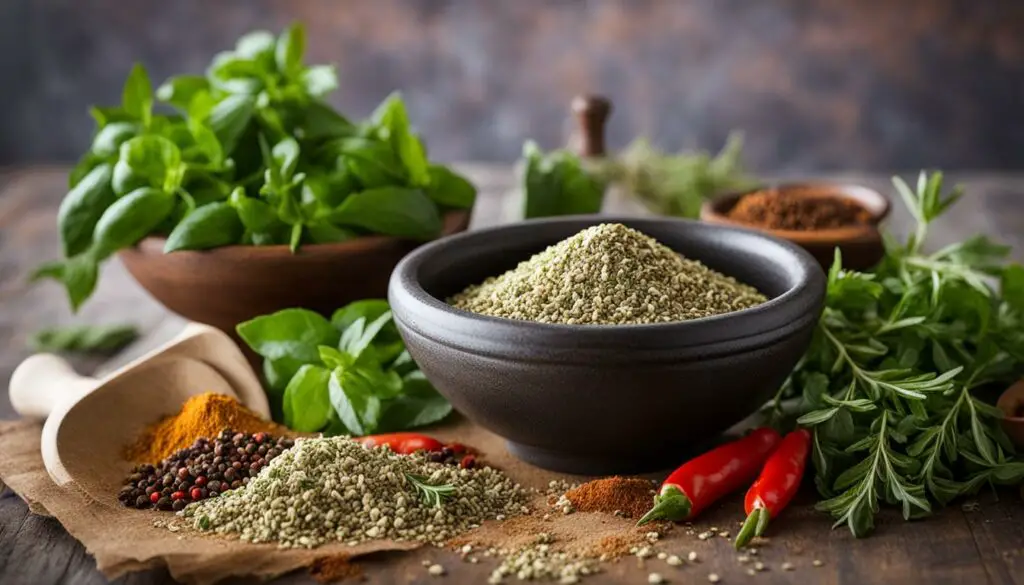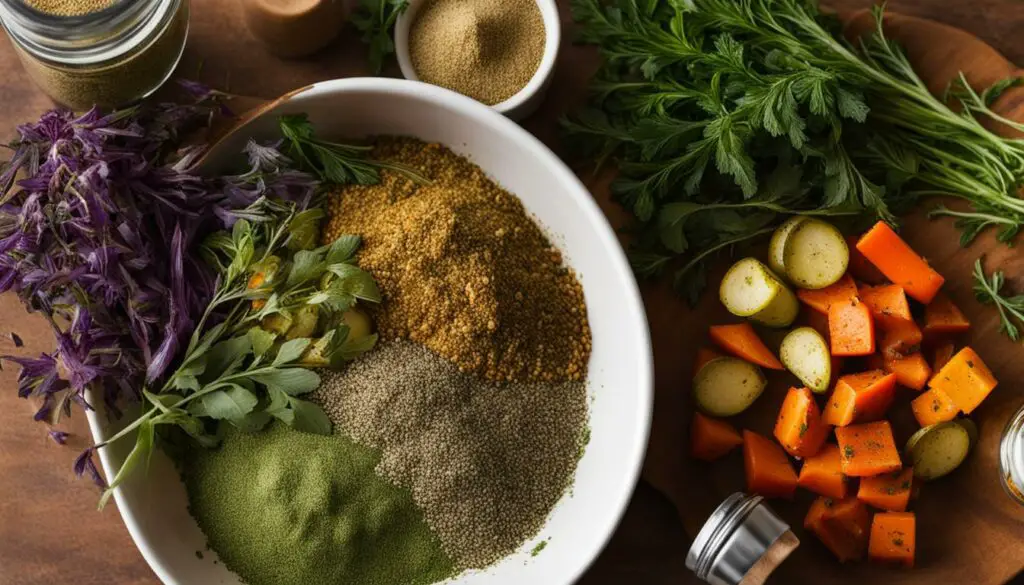Originally posted on November 17, 2023 @ 4:45 am
Do you love the unique and aromatic taste of za atar spice but find yourself without it in your pantry? Or perhaps you’re looking to switch things up and try something new in your recipes. Whatever the reason, we’re here to provide expert advice on finding the perfect za atar spice substitute for your culinary needs.
Before exploring substitutes, it’s important to understand the flavor profile and ingredients of za atar spice. This Middle Eastern spice blend typically includes a combination of dried herbs, sesame seeds, and sumac, adding a distinct and flavorful taste to various dishes.
Table of Contents
Key Takeaways:
- Za atar spice is a Middle Eastern spice blend that includes dried herbs, sesame seeds, and sumac.
- Substitutes can provide a similar flavor profile or a new twist to your recipes.
- Common substitutes include dried thyme, oregano, or a combination of herbs, and can be enhanced with complementary spices like cumin or coriander.
- When using substitutes, adjust the quantity and be open to exploring new flavor combinations.
- Consider trying alternatives like Italian seasoning or herbes de Provence for a unique twist on your dishes.
Understanding Za Atar Spice

If you’re looking for a za atar spice substitute or zaatar alternative, it’s essential to understand what za atar spice is and what gives it its unique flavor. Za atar is a popular Middle Eastern spice blend that typically includes dried herbs like thyme, oregano, and marjoram, as well as sumac and sesame seeds. The combination of these ingredients creates a nutty, tangy, and herbaceous flavor profile that’s perfect for seasoning meat, vegetables, and dips.
To make za atar spice, the dried herbs are ground together with sumac and sesame seeds. Sumac adds a tart and citrusy taste, while the sesame seeds provide a nutty and toasty flavor. While za atar spice is a staple in Middle Eastern cuisine, it’s become increasingly popular in other parts of the world as well, thanks to its versatility and unique taste.
Za Atar Spice and Its Alternatives
If you’re looking for a za atar seasoning swap, there are several alternatives that can mimic its flavor profile. You can create your own za atar spice substitute by mixing dried thyme, oregano, and marjoram together in equal amounts, and then adding sumac and toasted sesame seeds. This will provide a similar taste to za atar spice and can be used in a variety of dishes.
Other zaatar alternatives include using dried basil or mint in place of the thyme or oregano. While the flavor may not be exactly the same as za atar spice, it can still add a unique and delicious taste to your recipes. Experimenting with different herbs and spices can also lead to new and exciting flavor combinations.
TIP: When using a za atar spice substitute or alternative, start with a smaller amount and gradually add more until you achieve the desired taste. This will help you avoid adding too much or overpowering the dish.
Why Look for Za Atar Spice Substitutes?

While za atar spice is a delicious and versatile herb mix, there may be instances where you don’t have it on hand or prefer to try something different. That’s where za atar spice substitutes come in handy. These alternatives can provide a similar flavor profile or add a new twist to your recipes, making them an excellent herb mix replacement.
It’s also worth noting that za atar spice blends may not be available in all grocery stores or regions, making it challenging to source when needed. By exploring alternative options, you can always have a backup plan for when you need a za’atar seasoning swap.
“Substitutes can provide a similar flavor profile or add a new twist to your recipes.”
Using za atar spice substitutes can also be a great way to experiment with different flavors and herb combinations. For example, trying a zaatar herb substitute like dried thyme, oregano, marjoram, or a combination of these herbs can open up new possibilities and enhance the taste of your dishes. Additionally, zaatar seasoning alternatives can help you create unique flavor profiles in your cooking, whether you’re making your own spice blends or using pre-made options from different culinary traditions.
Common Za Atar Spice Substitutes

When looking for a za atar spice substitute, there are several options to choose from, including:
| Substitute | Flavor Profile |
|---|---|
| Dried Thyme | Earthy and slightly sweet |
| Oregano | Robust and slightly bitter |
| Marjoram | Sweet and slightly citrusy |
| Herb Blend (combination of thyme, oregano, and marjoram) | Floral and slightly tangy |
These substitutes can be used in various dishes, such as roasted vegetables, salads, and marinades. Experiment with different combinations and quantities to find the perfect flavor for your recipe.
In addition to these options, you can also try other herb blends as a za atar herb substitute, such as:
- Italian seasoning
- Herbes de Provence
- Ras el Hanout (a North African spice blend)
These blends may not have the exact flavor profile of za atar spice, but they can bring a unique twist to your dishes.
Remember to adjust the quantities based on the strength of the substitute and your personal taste preferences. Don’t be afraid to get creative and experiment with different herb and spice blends to find the perfect za atar seasoning alternative for your culinary needs.
Enhancing the Flavor of Za Atar Substitutes

To elevate the taste of your za atar spice substitutes, consider incorporating other complementary spices like cumin, coriander, or paprika. These additions can help to imitate the intricate and aromatic flavor of za atar spice and take your dish to the next level!
For instance, if you’re using dried thyme as a zaatar spice mix replacement, try adding a pinch of cumin or coriander to enhance its earthy notes. If you’re using a zaatar seasoning alternative that includes oregano, paprika can add a hint of smokiness and depth to the blend.
Experiment with different spice combinations to find the perfect balance for your recipe. A word of caution, though, don’t go overboard with the added spices, as they can overpower the delicate flavor of the herbs. It’s always best to start with a small amount and add more gradually, tasting as you go.
Tips for Using Za Atar Spice Substitutes

When using za atar spice substitutes, it’s important to consider their potency and adjust the quantity accordingly. Start with smaller amounts and gradually increase until you achieve the desired flavor. Additionally, keep in mind that za atar substitutes may have a slightly different taste profile, so be open to exploring new flavor combinations.
If you’re using a za’atar herb substitute, consider mixing it with other herbs to create a blend that mimics the complexity of za atar spice. For example, combine dried thyme, oregano, marjoram, and sumac to create a zaatar spice mix replacement.
When using herb blends, it’s important to note that the ratio of herbs can impact the flavor. Be mindful of the proportions you use, and adjust them according to your taste preferences.
To ensure your za atar substitute blends evenly and is well-distributed in your recipe, consider crushing the herbs and grinding them with sesame seeds in a mortar and pestle before using.
Expert Tip: “Don’t be afraid to get creative with your za atar spice substitutes. Experiment with different herb blends and complementary spices to create unique and flavorful dishes.” – Chef Ahmad, Middle Eastern Cuisine Specialist
Exploring Za Atar Spice Alternatives

While za atar spice substitutes can provide a similar flavor profile, there are also other exciting herb and spice blends from different culinary traditions to explore. Here are some delightful za atar spice alternatives to add a unique twist to your dishes:
Italian Seasoning
This herb blend typically includes basil, oregano, thyme, and rosemary and can be a great substitute for za atar seasoning. Italian seasoning adds a savory and slightly sweet flavor to your dishes, making it perfect for pasta, pizzas, and even roasted vegetables.
Herbes de Provence
Herbes de Provence is a French herb blend that typically includes a combination of dried herbs like lavender, thyme, and marjoram. It adds a delightful floral and earthy flavor to dishes and can be a great za atar spice replacement.
Homemade Spice Blends
Get creative and experiment with making your own spice blends. Combining dried herbs like thyme, oregano, and marjoram with other spices like fennel seeds, cumin, and coriander can create a unique za atar seasoning alternative that is perfectly tailored to your taste buds.
Explore new herb and spice blends to find the perfect za atar spice substitute.
Recommendations from Culinary Experts
When it comes to finding the perfect za atar spice substitute, who better to turn to than culinary experts? We asked some of the top chefs and food bloggers to share their recommendations for zaatar seasoning alternatives and za’tar substitutes that will take your cooking to the next level.
“One of my favorite za atar spice substitutes is a combination of dried thyme, sesame seeds, and sumac. It provides a similar depth of flavor to za atar and works particularly well in meat dishes.” – Chef Fatima Ali
If you’re looking for an herb mix replacement that you probably already have in your spice rack, food blogger Jessica Gavin suggests trying dried oregano or marjoram. “These herbs have a similar earthy flavor and work well in Mediterranean and Middle Eastern dishes,” she explains.
If you want to take your zaatar alternative game to the next level, consider experimenting with different spice blends. “A blend of coriander, cumin, and fennel seeds can add a unique twist to your recipes,” suggests culinary expert Chef Yotam Ottolenghi. Don’t be afraid to get creative and try new flavor combinations!
To make things easier, we’ve compiled a list of some of the most popular za atar spice substitutes and their recommended uses:
| Za Atar Spice Substitute | Recommended Uses |
|---|---|
| Dried Thyme, Sesame Seeds, and Sumac | Meat dishes, dips, and dressings |
| Dried Oregano or Marjoram | Mediterranean and Middle Eastern dishes |
| Dried Mint, Dried Thyme, and Ground Cumin | Vegetables, dips, marinades |
| Sumac, Dried Thyme, Dried Marjoram, and Toasted Sesame Seeds | Meat dishes, vegetables, dressings |
Don’t be afraid to experiment with different za atar spice substitutes and find one that works best for your culinary needs. Whether you’re cooking up a Middle Eastern feast or trying something new, these alternatives are sure to add some extra flavor to your favorite dishes.
Conclusion
In conclusion, finding the perfect za atar spice substitute can elevate your dishes to new heights of flavor. Whether you stick with common alternatives like dried thyme or explore other herb blends, there are plenty of options available to suit your culinary needs.
Remember to take into account the potency of your chosen substitute and adjust the quantity accordingly. Don’t be afraid to experiment with complementary spices to enhance the flavor profile of your dishes. And if you’re feeling adventurous, consider trying out other spice blends from different global culinary traditions.
With the right knowledge and tools at your disposal, you can create delicious and exciting meals that are sure to impress. So why wait? Start exploring the world of za atar spice substitutes today and take your cooking to the next level!
FAQ
What is za atar spice?
Za atar spice is a Middle Eastern spice blend that typically includes a combination of dried herbs, sesame seeds, and sumac. It is commonly used in Middle Eastern cuisine for its unique and flavorful taste.
Why should I look for za atar spice substitutes?
There may be instances where you don’t have za atar spice on hand or prefer to try something different. Za atar spice substitutes can provide a similar flavor profile or add a new twist to your recipes.
What are some common za atar spice substitutes?
Some common substitutes for za atar spice include dried thyme, oregano, marjoram, or a combination of these herbs. You can also experiment with different herb blends to create your own unique za atar substitute.
How can I enhance the flavor of za atar substitutes?
To enhance the flavors of your za atar substitutes, consider adding other complementary spices such as cumin, coriander, or paprika. These additions can help mimic the complex and aromatic taste of za atar spice.
Any tips for using za atar spice substitutes?
When using za atar spice substitutes, it’s important to consider their potency and adjust the quantity accordingly. Start with smaller amounts and gradually increase until you achieve the desired flavor. Additionally, be open to exploring new flavor combinations as za atar substitutes may have a slightly different taste profile.
Can I explore other alternatives to za atar spice?
Absolutely! While za atar spice substitutes can provide a similar flavor, it’s also exciting to experiment with other herb and spice blends from different culinary traditions. Consider trying alternatives like Italian seasoning, herbes de Provence, or even homemade spice blends to add a unique twist to your dishes.
Do you have any recommendations from culinary experts?
Yes! We have consulted with culinary experts specializing in Middle Eastern and global cuisine who have shared their insights on the best za atar spice substitutes and alternatives. Their recommendations ensure that your dishes will be bursting with flavor.
See also:
Leave a Reply